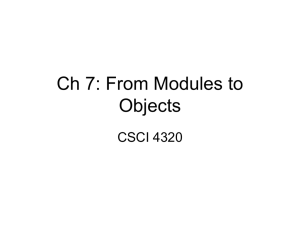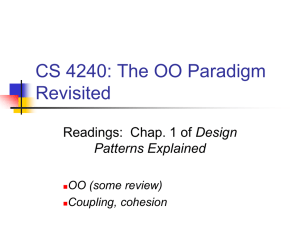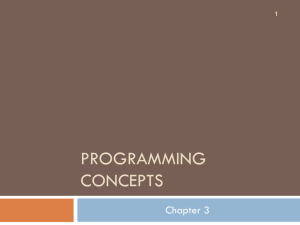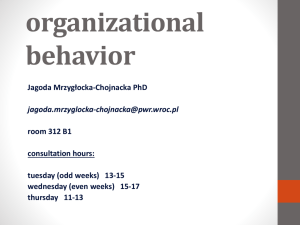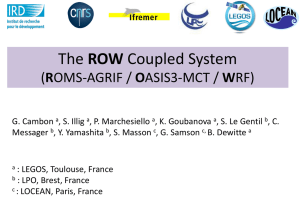chap12
advertisement
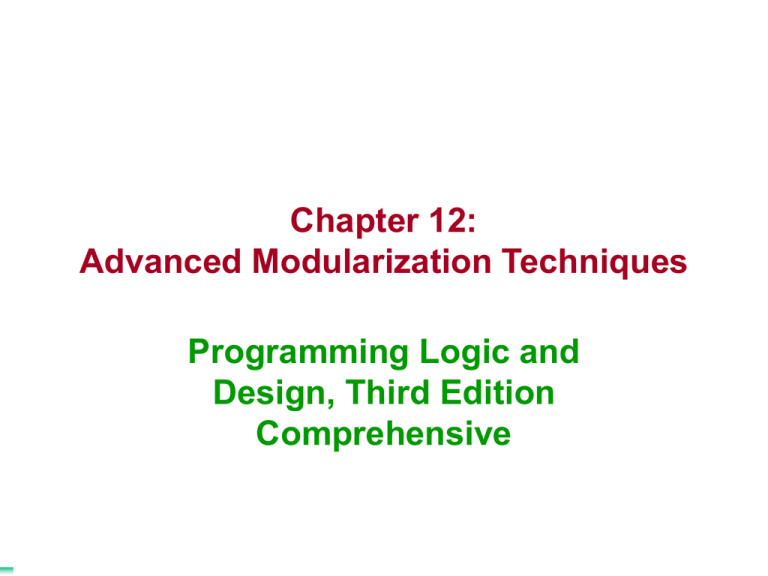
Chapter 12: Advanced Modularization Techniques Programming Logic and Design, Third Edition Comprehensive Objectives • After studying Chapter 12, you should be able to: • Understand local and global variables and encapsulation • Pass a single value to a module • Pass multiple values to a module • Return a value from a module Programming Logic and Design, Third Edition Comprehensive 2 Objectives (continued) • Use prewritten, built-in modules • Create an IPO chart • Understand the advantages of encapsulation • Reduce coupling and increase cohesion in your modules Programming Logic and Design, Third Edition Comprehensive 3 Understanding Local and Global Variables and Encapsulation • A procedural program consists of a series of steps or procedures that take place one after the other – Possible to write as one long series of steps • However, by now you should appreciate the benefits of modularization: – breaking programs into reasonable units called modules, subroutines, functions, or methods Programming Logic and Design, Third Edition Comprehensive 4 Understanding Local and Global Variables and Encapsulation (continued) • Benefits of modularization: – Provides abstraction: easier to see the “big picture” – Allows multiple programmers to work on a problem, each contributing one or more modules that later can be combined into a whole program – Allows you to reuse your work • you can call the same module from multiple locations within a program – Allows you to identify structures more easily Programming Logic and Design, Third Edition Comprehensive 5 Understanding Local and Global Variables and Encapsulation (continued) • Despite many benefits, two major drawbacks of modularization exist: – Although modules allow multiple programmers to work on a problem, • each programmer must know all variable names used in other modules within the program – Although modules enable you to reuse your work, • you can’t use modules in other programs unless these programs use the same variable names Programming Logic and Design, Third Edition Comprehensive 6 Understanding Local and Global Variables and Encapsulation (continued) • Global variable: – available to every module in a program – every module has access to the variable, can use its value, and can change its value • Local variable – name and value are known only to its own module – declared within a module – ceases to exist when the module ends Programming Logic and Design, Third Edition Comprehensive 7 Understanding Local and Global Variables and Encapsulation (continued) • Within a module, a variable is said to be in scope—that is, existing and usable—from the moment it is declared until it ceases to exist • then it is out of scope Programming Logic and Design, Third Edition Comprehensive 8 Mainline Logic for a Program That Uses Only Local Variables Programming Logic and Design, Third Edition Comprehensive 9 Understanding Local and Global Variables and Encapsulation (continued) • When you declare local variables within modules, you do so in a declare variables step • When you use local variables: – Programmers of other modules do not need to know your variable names – Each module becomes enclosed unit, declaring all the variables it needs Programming Logic and Design, Third Edition Comprehensive 10 Understanding Local and Global Variables and Encapsulation (continued) • The arithmetic drill program employs encapsulation (also know as information hiding or data hiding): – Data or variables are completely contained within—and accessible only to—the module in which they are declared Programming Logic and Design, Third Edition Comprehensive 11 The Modified housekeeping() Module Containing userAnswer Variable Programming Logic and Design, Third Edition Comprehensive 12 Passing a Single Value to a Module • Sometimes more than one module needs access to the same variable value • Consider a new arithmetic drill program – Instead of a single arithmetic problem, it is more reasonable to expect such a program to ask the user a series of problems and keep score • Figure 12-6 shows a revised askQuestion() module that accesses an array to provide a series of five questions for the arithmetic drill Programming Logic and Design, Third Edition Comprehensive 13 The Modified askQuestion() Module That Provides Five Problems and Keeps Score Programming Logic and Design, Third Edition Comprehensive 14 The Modified askQuestion() Module That Provides Five Problems and Keeps Score Programming Logic and Design, Third Edition Comprehensive 15 Passing a Single Value to a Module (continued) • The module shown in Figure 12-6 correctly counts and displays the number of correct answers for the user • However, suppose when the user completes the arithmetic drill, you want to print – the count of correct answers – the percentage of correct answers – one of two messages based on the user’s performance Programming Logic and Design, Third Edition Comprehensive 16 Passing a Single Value to a Module (continued) • The solution to using a locally declared variable within another module lies in a program’s ability to pass the value of a local variable from one module to the other – Passing a value means that you are sending a copy of data in one module of a program to another module for use Programming Logic and Design, Third Edition Comprehensive 17 The Modified askQuestion() Module That Passes correctCount to a finalStatistics() Module Programming Logic and Design, Third Edition Comprehensive 18 The Modified askQuestion() Module That Passes correctCount to a finalStatistics() Module Programming Logic and Design, Third Edition Comprehensive 19 Passing a Single Value to a Module (continued) • Figure 12-8 shows the finalStatistics() module for the program • To prepare this module to receive a copy of the correctCount value, you declare – a name for the passed value within parentheses in the module header, – or introductory title statement of the module • The passed variable named within the module header often is called a parameter or an argument Programming Logic and Design, Third Edition Comprehensive 20 The finalStatistics() Module That Receives correctCount Value and Calls It numRight Programming Logic and Design, Third Edition Comprehensive 21 Passing Multiple Values to a Module (continued) • In the finalStatistics() module of the arithmetic drill program in Figure 12-8, – numRight, percentCorrect, and cutOff all remain in scope from the point at which they are declared until the end of the module • After the finalStatistics() module receives its argument, – it contains everything it needs to calculate the percentage of addition problems that the user answered correctly and to determine which message to display Programming Logic and Design, Third Edition Comprehensive 22 Passing Multiple Values to a Module (continued) • Figure 12-9 shows a module named quickQuit() that includes a call to a finalStatistics() module that accepts two arguments, numRight and numPossible • This version of the numPossible argument makes the module more flexible • The series of arguments that appears in the module header is called an argument list Programming Logic and Design, Third Edition Comprehensive 23 The quickQuit() Module That Passes Two Arguments to the finalStatistics() Module Programming Logic and Design, Third Edition Comprehensive 24 The quickQuit() Module That Passes Two Arguments to the finalStatistics() Module Programming Logic and Design, Third Edition Comprehensive 25 Returning a Value From a Module (continued) • Suppose you decide to organize the arithmetic drill program from Figure 12-9 so that – the finalStatistics() module still computes the user’s correct percentage, but – the calling module handles the printing of the final statistics Programming Logic and Design, Third Edition Comprehensive 26 Returning a Value From a Module (continued) • In this case, you – pass the values of the count of correct questions and the total number of questions available to the finalStatistics() module as before – the finalStatistics() module must return the value of the calculated correct percentage back to the calling module Programming Logic and Design, Third Edition Comprehensive 27 Returning a Value From a Module (continued) • The giveQuiz() module (in figure 12-10) – declares an array of questions – declares a parallel array holding correct answers – displays each question in sequence – compares the user’s answer to the correct answer – determines whether to add 1 to a variable used to keep track of the number of correct responses Programming Logic and Design, Third Edition Comprehensive 28 A giveQuiz() Module That Sends Values to an Receives a Value Returned From a finalStatistics() Module Programming Logic and Design, Third Edition Comprehensive 29 A giveQuiz() Module That Sends Values to an Receives a Value Returned From a finalStatistics() Module Programming Logic and Design, Third Edition Comprehensive 30 Returning a Value From a Module (continued) • The use of a data type preceding the method header indicates the type of data that will be returned by the module – follows the format for methods that return values in many programming languages, such as C++, Java, and C# • The return type of a method is called the method’s type or method’s return type Programming Logic and Design, Third Edition Comprehensive 31 Using Prewritten, Built-In Modules • Many programming languages contain built-in methods or built-in functions: – prewritten modules that perform frequently needed tasks • To see whether a language contains a built-in module – examine the program language documentation – for example, you can read the manual that accompanies a language compiler, search through online help, or examine languagespecific textbooks Programming Logic and Design, Third Edition Comprehensive 32 Using Prewritten, Built-In Modules (continued) • When you have an available module that suits your needs, find: 1. The name of the method 2. The arguments you need to pass to the method, if any 3. The type of value returned from the method, if any • A statement such as num sqrt(num) is called the method’s signature • The signature fully describes how you can use the method Programming Logic and Design, Third Edition Comprehensive 33 Using Prewritten, Built-In Modules (continued) • Do not need to understand how square root is calculated within the function – the method acts as a black box: • device you can use without understanding the internal processes • Each version of the abs() method (figure 12-11) returns the absolute values of a number • Absolute value: – positive value of the number – Example: the absolute value of –5 is 5, and the absolute values of 17 is 17 Programming Logic and Design, Third Edition Comprehensive 34 Three Versions of an abs() Function Programming Logic and Design, Third Edition Comprehensive 35 Using an IPO Chart • When designing modules to use with larger programs, helpful to use an IPO chart – identifies and categorizes each item needed within the module as pertaining to input, processing, or output – Like a flowchart or pseudocode, an IPO chart is just another tool to help you plan the logic of your programs Programming Logic and Design, Third Edition Comprehensive 36 Understanding the Advantages of Encapsulation • When writing a module that receives a variable, you can give the variable any name you like – Especially beneficial because a well-written module may be used in dozens of programs, each supporting its own unique variable names • Passing values to a module helps facilitate encapsulation Programming Logic and Design, Third Edition Comprehensive 37 Understanding the Advantages of Encapsulation (continued) • A programmer can write a program (or module) and use procedures developed by others without knowing the details of those procedures; – the programmer can use the modules as black boxes • When procedures use local variables, the procedures become miniprograms that are relatively autonomous • Routines that contain their own sets of instructions and their own variables are not dependent on the program that calls them Programming Logic and Design, Third Edition Comprehensive 38 Understanding the Advantages of Encapsulation (continued) • The details within a routine are hidden and contained, or encapsulated – helps to make the routine reusable • Many real-world examples of encapsulation exist – When you build a house, you don’t invent plumbing and heating systems – You incorporate systems that have already been designed Programming Logic and Design, Third Edition Comprehensive 39 Understanding the Advantages of Encapsulation (continued) • Reliability is a feature of programs or modules that have been tested and proven to work correctly • Software that is reusable – saves time and money – is more reliable • If the finalStatistics() module has been tested previously, – you can be confident that it will work correctly when you use it within a different program Programming Logic and Design, Third Edition Comprehensive 40 Reducing Coupling and Increasing Cohesion • When deciding how to organize your program steps into modules, you should adhere to two general rules: – Reduce coupling – Increase cohesion Programming Logic and Design, Third Edition Comprehensive 41 Reducing Coupling • Coupling – measure of the strength of the connection between two program modules – is used to express the extent to which information is exchanged by subroutines – is either tight or loose, based on how much one module depends on information from another Programming Logic and Design, Third Edition Comprehensive 42 Reducing Coupling (continued) • Tight coupling: – occurs when modules excessively depend on each other – makes programs more prone to errors • many data paths to keep track of • many chances for bad data to pass from one module to another • many chances for one module to alter information needed by another module Programming Logic and Design, Third Edition Comprehensive 43 Reducing Coupling (continued) • Loose coupling: – occurs when modules do not depend on others • Data coupling: – loosest type of coupling – most desirable • Data coupling is also known as simple data coupling or normal coupling – occurs when modules share a data item by passing parameters Programming Logic and Design, Third Edition Comprehensive 44 Reducing Coupling (continued) • Data-structured coupling: – similar to data coupling, but an entire record is passed from one module to another • For example, consider a module that determines whether a customer applying for a loan is creditworthy • You might write a module that receives the entire customer record and uses many of its fields in order to determine whether the customer should be granted the load Programming Logic and Design, Third Edition Comprehensive 45 Reducing Coupling (continued) • If you need many of the customer fields—such as salary, length of time on the job, savings account balance, and so on—then it makes sense to pass a customer’s record to a module Programming Logic and Design, Third Edition Comprehensive 46 Reducing Coupling (continued) • Control coupling occurs when a main program (or other module) passes a parameter to a module, controlling the module’s actions or telling it what to do Programming Logic and Design, Third Edition Comprehensive 47 Reducing Coupling (continued) • External coupling and common coupling occur, respectively, when two or more modules access the same global variable or record • When data can be modified by more than one module, – programs become harder to write, read, and modify – if you make a change in a single module, many other modules can be affected Programming Logic and Design, Third Edition Comprehensive 48 Reducing Coupling (continued) • Pathological coupling: – when two or more modules change one another’s data – makes programs extremely difficult to follow – should be avoided at all costs • An especially confusing case occurs when moduleOne() changes data in moduleTwo(), moduleTwo() changes data in moduleThree(), and moduleThree() changes data in moduleOne() Programming Logic and Design, Third Edition Comprehensive 49 Increasing Cohesion • Analyzing coupling lets you see how modules connect externally with other modules and programs • You also want to analyze a module’s cohesion: – how internal statements of a module or subroutine serve to accomplish the module’s purposes • Functional cohesion: – occurs when all operations in a module contribute to the performance of only one task Programming Logic and Design, Third Edition Comprehensive 50 Increasing Cohesion (continued) • Functional cohesion is the highest level of cohesion; you should strive for it in all methods you write • For example, a module that calculates gross pay appears below Programming Logic and Design, Third Edition Comprehensive 51 Increasing Cohesion (continued) • Two types of cohesion are considered inferior to functional cohesion, but still acceptable • Sequential cohesion – takes place when a module performs operations that must be carried out in a specific order on the same data – is a slightly weaker type of cohesion than functional cohesion • even though the module might perform a variety of tasks, the tasks are linked because they use the same data, often transforming the data in a series of steps Programming Logic and Design, Third Edition Comprehensive 52 Increasing Cohesion (continued) • Communicational cohesion: – occurs in modules that perform tasks that share data • Tasks are not related; only the data items are • Temporal cohesion: – takes place when the tasks in a module are related by time • Procedural cohesion: – takes place when, as with sequential cohesion, the tasks of a module are performed in sequence – do not share data Programming Logic and Design, Third Edition Comprehensive 53 Increasing Cohesion (continued) • Main program modules – are often procedurally cohesive – consist of a series of steps that must be performed in sequence – perform very different tasks, such as housekeeping(), mainLoop(), and finishUp() • Main module, or dispatcher module: – dispatches messages to a sequence of more cohesive modules Programming Logic and Design, Third Edition Comprehensive 54 Increasing Cohesion (continued) • Logical cohesion: – takes place when a member module performs one or more tasks depending on a decision, whether the decision is in the form of a case structure or a series of if statements – actions performed might go together logically (that is, perform the same type of action), but they don’t work on the same data • Coincidental cohesion: – based on coincidence—that is, the operations in a module just happen to have been placed together Programming Logic and Design, Third Edition Comprehensive 55 Increasing Cohesion (continued) Programming Logic and Design, Third Edition Comprehensive 56 Summary • A procedural program consists of a series of steps or procedures that take place one after the other • When multiple modules need access to the same variable value, you can pass a variable to the module • Just as you can pass a value into a module, you can pass back or return a value from a called module to a calling module Programming Logic and Design, Third Edition Comprehensive 57 Summary (continued) • Many programming languages provide built-in methods, which are preprogrammed modules you can use to perform common tasks • The concept of passing variables to modules allows programmers to create variable names locally in a module without changing the value of similarly named variables in other modules • When writing modules, you should strive to achieve loose coupling and high cohesion Programming Logic and Design, Third Edition Comprehensive 58
